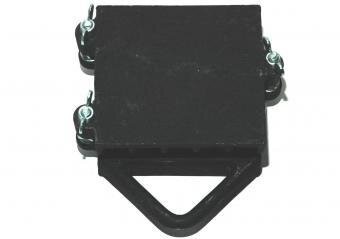........ our clews are becoming unusable. ....... my crew keeps telling me that there are some clews that have bad springs in them. Some of these bad clews have been laying around for a few years, so nobody can remember what exactly is wrong with them.......What is the best way to tell if there is anything wrong with the inner workings of a
clew with out having to put it into use?....Also, if new inner workings are needed ..........where could I find them. ? ........
I first learned rigging in hemp houses, the last one I worked in was in the early 80's, the Walnut in Philadelphia. I do still have a grand fondness for a well maintained hemp
house with a skilled and well trained crew. I could reminisce for hours, but, this is not the time or place.
The best way to learn about the spring loaded pawl type of rope
clew is to obtain a new one. Open it up and feel the tension in the springs. Put a couple lengths of rope in it and tie them off to something solid in your shop. Grab the weight loop with the strongest spring balance scale you can find (a
load cell and a come-a-long would be the best) and pull. Note how tight the
wing nuts must be, before the rope is "locked in". Pull the rope the other way, in the "up" direction. The rope should move reasonably in the up direction and "lock" in the down or weight bearing direction. Because each rope is a little different, especially if the rope is a natural fiber rope, there is no exact setting or torque you can measure that is right. It is a "feel" thing.
Next, take one apart, look at the springs the pawls and the way they are assembled and how they move. Check the way the pawls pivot and how they fit in. Note the normal length and diameter of the spring, the
wire gauge it is made of, and measure the weight needed to compress the spring. These are the parameters you will find in spring listings in industrial supply catalogs from vendors such as McMaster, et.al. As others have said, contact the vendor from whom you purchased the
clew and ask about the manufacturer or if they will sell repair and maintenance parts. Compare the cost of parts, shipping, and the labor time to do the repair. And no, just because you are (might be) on salery rather than hourly does not mean labor costs nothing. The time you spend doing this is time you are not working some other project, so it costs, even if you don't assign a specific labor charge to it. Compare the costs versus the
purchase of a new product to determine which course of action is best for you.
After examining a new one, try the same tests on one of the old ones. does it take the same amount of force to compress the springs? Will it "lock" on the rope in the down direction but allow the rope to pull through in the other direction? Does it still allow the rope to pull through even when the nuts are completely tightened down? Are the pawl pivots secure but allow free movement? Are the pivots loose or do the pawls jamb tight without closing down on the rope? If the
clew lists an acceptable
WLL and you do have a
load cell and come-a-long, check to see if the
clew will hold that amount of tension and hold it, say, over night, without slipping.
No exact science, just good judgement and common sense. If it looks like it is about to break, it will. If it looks like the pawl
face is worn too smooth to grab the rope, it is. If there any fracture cracks anywhere in the housing, discard it. If a spring is mushy, replace it. Nuts and bolts, well you know!
One thing, the spring loaded type of rope
clew IS NOT a way to run 4 or 5 lines to a single
line for handling and tie off, it is a WEIGHT
clew, designed to hold the sand bag counter weights only. When properly used, the sand bags clip to the weight loop, but all the lift lines run to the
rail to be tied off. Never rely on the
clew to safely hold the load when tied off. If any
line in the
clew slips for any reason, and the tie off is to the
clew, the slipping will continue and probably increase until the load falls. If, however, the lines are all tied off and the
clew slips, the load simply stays in place until the problem is noticed and corrected. This last advice also applies to the single piece, cast type of rope
clew, it IS a weight
clew, NOT a ganging
clew.
This probably sound a
bit vague, but I hope it helps.



